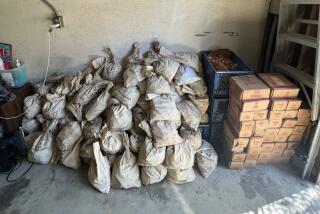10 Rare Double Eagles Confiscated
- Share via
PHILADELPHIA — The U.S. Mint has seized 10 Double Eagle gold coins from 1933, among the rarest and most valuable coins in the world, that a jeweler says she turned in to determine their authenticity.
Joan S. Langbord will file a lawsuit to try to recover them, her lawyer, Barry H. Berke, said Wednesday.
Langbord found the coins among the possessions of her late father, longtime jeweler Israel Switt. She operates her father’s business.
David Lebryk, acting director of the Mint, had announced in a news release that the rare coins, which were never put in circulation, had been taken from the Mint “in an unlawful manner” in the mid-1930s and now were “recovered.”
The coins are public property, he said.
Berke said Mint officials could not prove the coins had been stolen or were subject to forfeiture. But Mint officials said Thursday that the Double Eagles could not have legally been taken from the Mint.
In 2002, Sotheby’s and numismatic firm Stack’s auctioned off a 1933 Double Eagle coin for $7.6 million, the highest price ever paid for a coin. That Double Eagle, believed to have been part of a collection belonging to King Farouk of Egypt, surfaced when a coin dealer tried selling it to undercover Secret Service agents.
After a legal battle, the dealer was permitted to sell the coin at auction on the condition he split the proceeds with the Mint. One of the terms of the settlement was that it would not set a precedent for future Double Eagles.
In its statement, the Mint said officials were still deciding what to do with the seized coins, which are being held at Ft. Knox. They said they had no plans to auction them.
Double Eagles were first minted in 1850 with a face value of $20. The 445,500 coins minted in 1933 were never put into circulation because the nation went off the gold standard. All the coins were ordered melted down, but some were believed to have survived, including two handed over to the Smithsonian Institution.
Langbord declined to discuss how the coins might have wound up with her father, who operated an antiques and jewelry shop for 70 years and died in 1990 at 95.
The Mint contends Switt obtained a cache of the gold coins from his connections at the Mint just before they were to be reduced to bullion in 1937.
Switt admitted in 1944 that he had sold nine Double Eagle coins, but he was not charged in connection with those transactions, the Mint said.
The family’s lawyer said the coins were found recently, and Langbord and her son, Roy, notified the Mint of the discovery in September. Mint officials asked to authenticate the coins, then confiscated them after doing so, Berke said.
He contended Langbord and her son never relinquished their right to the coins.
More to Read
Sign up for Essential California
The most important California stories and recommendations in your inbox every morning.
You may occasionally receive promotional content from the Los Angeles Times.













